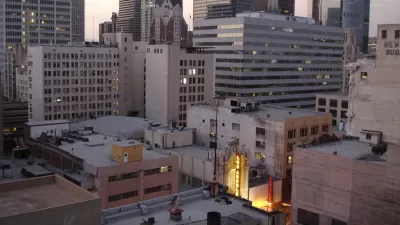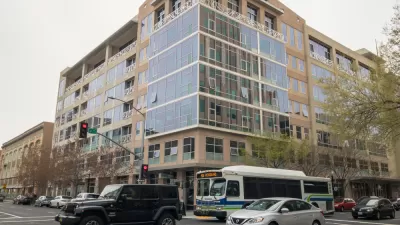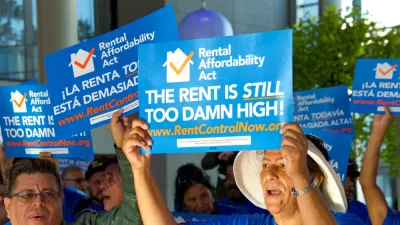California's redevelopment program was killed during the budget fallout of the Great Recession. Now more state politicians see how tax increment devoted to development investments could be one tool int he state's affordable housing crisis.

The Los Angeles Times Editorial Board suggests that the time has come for the state of California to revamp the idea of redevelopment agencies—an idea defunct since former Governor Jerry Brown axed the investment program in the height of the budget austerity of the Great Recession.
The editorial suggests that some of the state's affordable housing shortage could be alleviated by the reintroduction of redevelopment. Instead of the flawed system in place prior to the recession, the editorial calls for a Redevelopment 2.0.
Cities need an ongoing source of money for affordable housing. This is especially important as [Governor Gavin] Newsom and state lawmakers are pushing cities to zone for more homes for Californians at all income levels. Although the need for more market-rate housing can be addressed by lowering regulatory and political barriers, the critical shortage of affordable units is both a political and a financial problem. Simply put, developers can’t produce the amount of affordable housing needed without public subsidies.
Governor Gavin Newsom, in office since the beginning of the year, has spoken in favor of Redevelopment 2.0 before, but he hasn't been consistent on the issue—even as a bill to pursue a new redevelopment program, Assembly Bill 11, died in the Legislature in May. Another attempt at crafting legislation to revive redevelopment is also contained in Senate Bill 5, authored by State Senator Jim Beall (D-San Jose).
The editorial concludes with cautious support for the idea of redevelopment: "The idea behind redevelopment — to give local governments the ability to launch community revitalization projects that the private sector wouldn’t do alone — is still worthwhile. And the needs are at least as great."
FULL STORY: Editorial: Jerry Brown killed redevelopment in California. Gavin Newsom should bring it back to life

Maui's Vacation Rental Debate Turns Ugly
Verbal attacks, misinformation campaigns and fistfights plague a high-stakes debate to convert thousands of vacation rentals into long-term housing.

Planetizen Federal Action Tracker
A weekly monitor of how Trump’s orders and actions are impacting planners and planning in America.

San Francisco Suspends Traffic Calming Amidst Record Deaths
Citing “a challenging fiscal landscape,” the city will cease the program on the heels of 42 traffic deaths, including 24 pedestrians.

Bend, Oregon Zoning Reforms Prioritize Small-Scale Housing
The city altered its zoning code to allow multi-family housing and eliminated parking mandates citywide.

Amtrak Cutting Jobs, Funding to High-Speed Rail
The agency plans to cut 10 percent of its workforce and has confirmed it will not fund new high-speed rail projects.

LA Denies Basic Services to Unhoused Residents
The city has repeatedly failed to respond to requests for trash pickup at encampment sites, and eliminated a program that provided mobile showers and toilets.
Urban Design for Planners 1: Software Tools
This six-course series explores essential urban design concepts using open source software and equips planners with the tools they need to participate fully in the urban design process.
Planning for Universal Design
Learn the tools for implementing Universal Design in planning regulations.
planning NEXT
Appalachian Highlands Housing Partners
Mpact (founded as Rail~Volution)
City of Camden Redevelopment Agency
City of Astoria
City of Portland
City of Laramie





























